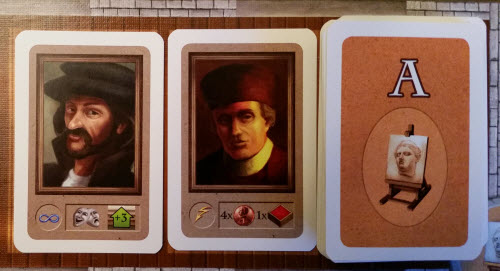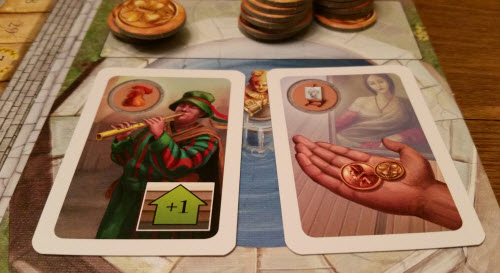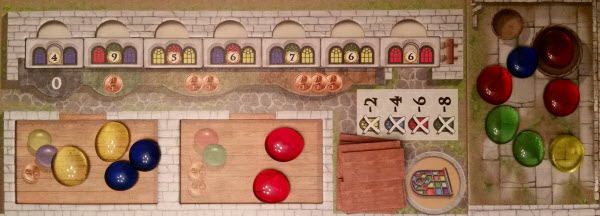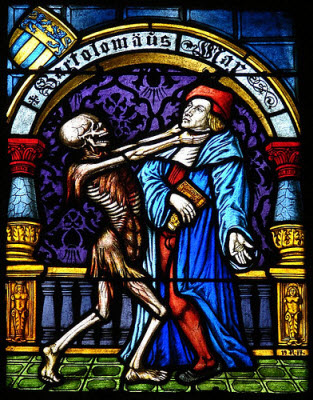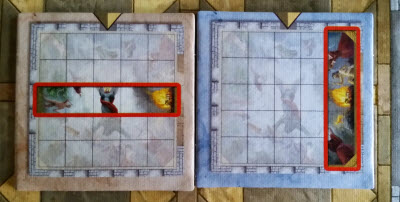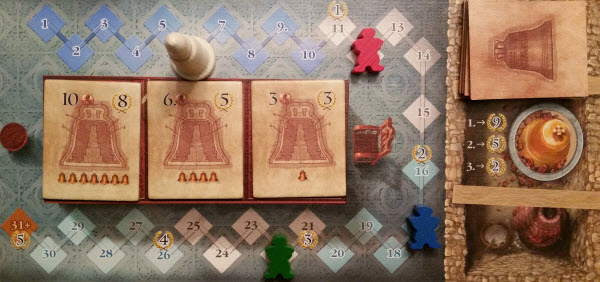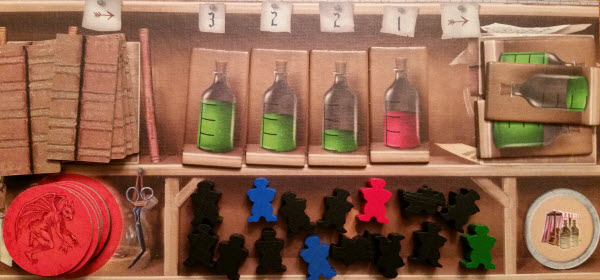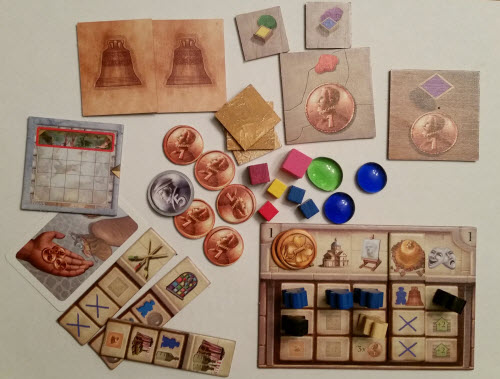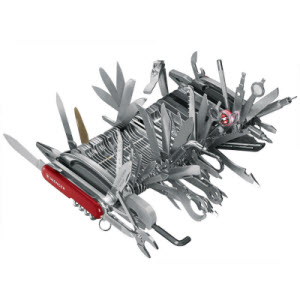Note: This section pertains to the expansions found in the Fresco Big Box. For the review of the base game, click here.
Fresco Big Box Expansions
To jump to a particular expansion, click below:
Expansion 2: The Bishop’s Request
Expansion 3: Special Blend Colors
Expansion 11: The Bishop’s Favor
Expansion 1: The Portraits
Hearing that famous artists will be in the region, many important individuals are seeking to have their portraits painted.
Rules Creep Factor
The Portraits is a minor expansion to Fresco, adding a single deck of cards at the Studio location where the money is housed. (The money is moved either to the table or to the Bank board supplied with the Big Box.) Each round, two new Portrait cards are revealed, offering either one-time or permanent bonuses of money, VP, Morale, and / or paint, as well as a new endgame trigger if the deck runs out. A player may use one Apprentice action a round at the Studio to take a Portrait card, if available.
The Rundown
The Portraits expansion has a little impact on Fresco, although what influence it does have is highly positive. The Portraits alleviate one of the few real complaints about the base game, offering up more reasons to the Studio location beyond simply getting money. With the possible exception of the Bishop-moving Sexton card (which can be powerful in the right hands) most of the cards provide mild benefits that are nice to get but not game-shattering if you don’t. Still, this puts the Studio into play as a minor strategic location without messing with what works. If anything, The Portraits make Fresco even more dynamic and interesting.
Expansion 2: The Bishop’s Request
The bishop is offering up special tasks for players to fulfill. In exchange for their time and effort, players are rewarded with useful materials.
Rules Creep Factor
The Bishop’s Favor is a minor expansion to Fresco, adding twelve new Request tiles to the Workshop location where the paints are housed. (The paints are moved either to the table to the Paints board supplied with the Big Box.) Request tiles are stacked in four piles of three in descending VP value, with one stack for each color (Green, Orange, Purple, and Generic).
A player may use one Apprentice action a round at the Workshop to fulfill a Request. The player turns in three completed fresco tiles of the same color paint splotches for a colored Request tile, or any three tiles for a generic one. They score the VP amount and flip them over. At the end of each round, in addition to a normal residual income, the player will collect that color paint token as well.
The Rundown
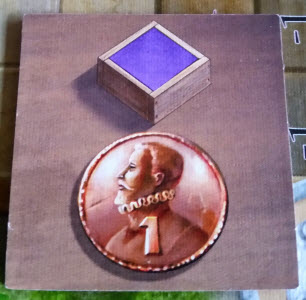
The color of victory.
The Bishop’s Favor, much like The Portraits, alleviates the base game issue of the Workshop being an underutilized location, and it only has a marginally larger impact on the game. The biggest aspect to the requests is that by completing them you’re not only gaining VP, but you’re now collecting free paint every round. This is especially advantageous if you can land the all-important Purple Requests, as a free Purple paint every round is easily worth the effort.
It does come with some small tradeoffs, as you’re losing that paint mixing action, and, more importantly, you are effectively swapping that paint residual for a loss of two Thalers every round. Bishop’s Favor proves to be a highly worthwhile small expansion to the game, though, providing new strategic opportunities and another way to get VP without altering the flow of the game. Its one caveat is that if the point leader is the only one focusing on Request tiles, it can disrupt the game’s innate equalizing effect. Given that you need completed fresco tiles to even use this action, it can make it easier for them to stay in the lead if they are uncontested.
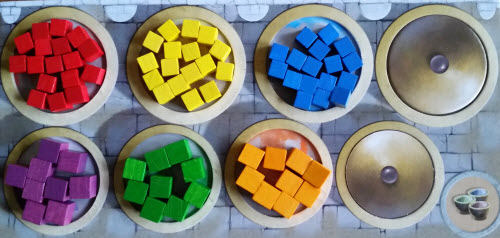
Behold the Paints board!
Expansion 3: Special Blend Colors
The powers that be decide that the fresco should be even more colorful, adding in new paints to the mix.
Rules Creep Factor
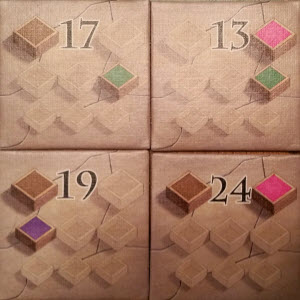
New heavy hitters
The Special Blend expansion has very little rules changes beyond setup. It adds two new tertiary colors to the paint supply (Pink and Brown), which are made the same way as secondary colors.
The expansion comes with seven fresco tiles that require these new colors and are worth substantially more VP than those in the base game. These tiles randomly replace existing fresco tiles in the setup, including a new 24-point center tile over the standard 11, as well as corresponding additions to Altar scoring.
The Rundown
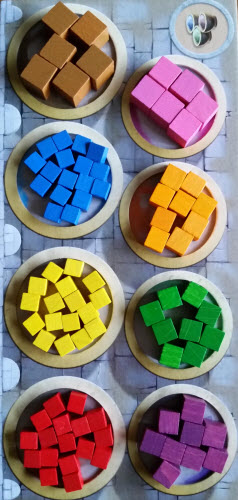 First off, it’s very impressive that the indented Paints board already has room for these additional two colors, complete with two cover pieces for when they are not in use, and it is certainly a nice touch.
First off, it’s very impressive that the indented Paints board already has room for these additional two colors, complete with two cover pieces for when they are not in use, and it is certainly a nice touch.
As for the expansion itself, the Special Blend is perhaps not as aptly named; there isn’t a whole lot special about it. The main impact the expansion has is that it adds about a half hour of play time to the game since it will take slightly longer for the players to build up to the third tier of paints necessary to complete fresco tiles. Hence why they are worth so much more: it’s one more hurdle to jump through.
Ultimately, the Special Blend expansion mainly just slows the pace of the game down slightly and reduces the frequency that point leaders shift around. It makes for a decent variant on the game and can pair well with other smaller expansions, but it isn’t one you’ll likely want to use every time.
Expansion 4: The Wishing Well
Players are experiencing a string of good luck lately, and many are attributing that luck to the use of an old well in the marketplace.
Rules Creep Factor
The Wishing Well expansion adds a small new board to the game, along with a supply of Lucky Pennies and a deck of Wishing cards. At the beginning of the game, each player receives three Lucky Pennies.
When a player assigns an Apprentice to the Market, they may take up to two Lucky Pennies with them. Before taking their action, the player may put up to two Pennies on the Wishing Well board as a free action, drawing a Wishing card for each one. The Wishing Well may only hold two Pennies a round, however. Unused Pennies are not lost if unused, though, and are worth 1 Thaler at the end of the game.
Wishing Cards provide minor one-time benefits when spent. Each card (with the exception of the Busker card) can be turned in when as part of an Apprentice’s action at the designated location, providing things such as money, Morale, free paint, and more Lucky Pennies.
The Rundown
The Wishing Well is a relatively small expansion to Fresco, and upon first glance it seems like it would have a larger impact on the game than it does. Indeed, the most surprisingly thing about this expansion is that it really doesn’t affect the game in any major way. At best it provides some marginal bonuses, on par with those in The Portraits (Expansion 1). At worst, it has no effect at all.
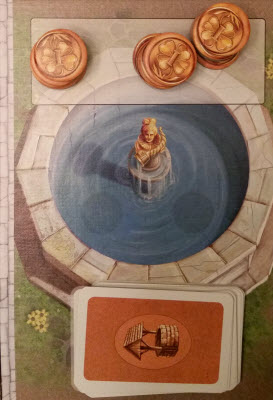
No Penny diving!
The Wishing Well does a decent job at being flavorful, though. The idea of dropping a Penny in the well and being rewarded for it is a harmless bit of fun. Plus, you know, free stuff. It also wisely makes the Penny drop a free action since people with Pennies ahead of you in turn order will almost assuredly take those spots.
There’s also little incentive to hold on to the Pennies until the end of the game, as any of the cards you draw are going to be more useful than 1 Thaler. Don’t be surprised if people just keep trying to chuck those coins every time they go to the Market. What’s more, the only way to get more Lucky Pennies is via Wishing cards. If you don’t receive any more, your luck has run out.
It’s unclear whether there’s real magic in the Wishing Well, but the expansion doesn’t add or subtract from a player’s strategies. Rather, it’s pure luck of the draw. If you desire a simpler game of Fresco, you’re not missing anything by skipping it. That said, if you want a little more thematic flavor to your game, there’s no harm dropping it in.
Expansion 5: The Leaf Gold
The ever-involved bishop wants to accentuate the fresco paints by occasionally offering up gold leaf to the mixtures.
Rules Creep Factor
The Leaf Gold expansion is another small expansion with an additional board, and is simpler to process than it first appears. This module comes with a storage board for stacks of leaf gold tiles, as well as a tile indicator added to the marketplace which points at two different Market tile locations. Whenever a player is at the Market and selects a paint tile at one of those two locations, they also receive leaf gold tiles.
At the beginning of each round, a colored disk is randomly drawn matching one of the six paint colors. Anytime during that round if a player completes a fresco tile containing the paint matching the colored disk, they can turn in a leaf tile along with the paints for extra VP. The VP bonus is almost identical to that of the Bishop. Any unused leaf gold at the end of the game is worth 1 Thaler each.
The Rundown
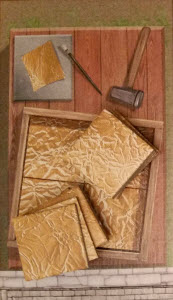 If The Wishing Well (Expansion 4) is an expansion all about theme, Leaf Gold is strictly just about capitalizing on some luck-based extra points. Leaf Gold offers players an opportunity to effectively double the Bishop’s usefulness – so long as you can match the paint color that round. Moreover, it opens up yet another avenue of competition and decisions to make at the Market, as only two spaces will provide you with the leaf gold. Do you take a less desirable paint tile in exchange for the gold or not? It’s a question you now have to ask yourself.
If The Wishing Well (Expansion 4) is an expansion all about theme, Leaf Gold is strictly just about capitalizing on some luck-based extra points. Leaf Gold offers players an opportunity to effectively double the Bishop’s usefulness – so long as you can match the paint color that round. Moreover, it opens up yet another avenue of competition and decisions to make at the Market, as only two spaces will provide you with the leaf gold. Do you take a less desirable paint tile in exchange for the gold or not? It’s a question you now have to ask yourself.
What the expansion effectively offers is an alternative painting strategy that hinges a little more on chance and less on meticulous planning, while still holding to the tight point jockeying of the base game. With enough leaf gold and paint at the ready, it’s possible to make some substantial bonus points each round by working around the Bishop’s location…so long as the right colored disk comes up.
In isolation, Leaf Gold is a decently simple expansion for Fresco, but it runs into two problems. First, you will likely have unusable leaf gold at the end of the game, and although it is converted into coin, it’ll feel like a wasted resource. Second, this otherwise minor expansion’s usefulness drops when used in tandem with other expansions that offer larger point bonuses and point swings (namely Expansions 3, 6, and 7).
Expansion 6: The Glaziers
Apparently, with the restoration of the ceiling fresco well in hand, the bishop has moved on to his next great task in the form of stained glass windows.
Rules Creep Factor
The Glaziery is one of the larger expansions for Fresco, adding a whole new aspect to completing fresco tiles. It centers around an indented glaziery board that tracks available stained glass tokens and window tiles.
Glass tokens are randomly drawn each round, much like Market paint tiles. These tokens come in four colors and are needed to complete window tiles – which are now required for about half of the game’s fresco locations. To purchase them, The Glaziery provides a new action space on worker boards that temporarily replaces one of the five base locations with a trip to the glaziery instead, as chosen by the player. Each glaziery action allows the purchase one glass token, and it provides two free Apprentice actions there by default.
When completing an outside-facing fresco in the Cathedral, the player must now also additionally complete a window tile by purchasing one of six available window tiles and drawing its replacement. Each window tile has a VP amount and two or three colored glass panes. The player adds the window’s VP to the fresco tile’s VP and spends the matching glass tokens. For each glass token missing, however, points are subtracted from the combined fresco/window total before scoring. Players are also able to spend extra glass tokens for VP during an Altar action.
The Rundown
The Glaziery is the second most impacting expansion for Fresco, and it’s evident from the onset that it significantly raises the challenge of completing parts of the fresco. Not only are you now required almost 50% of the time to buy stained glass in addition to the normal task of painting, but you also have to invest money into attaining the necessary glass tokens and buying the most desirable window available. It’s nice that you don’t have to spend actual Apprentices to buy glass if you don’t want to due to its free actions, but it also takes up one of your normal five location slots. This slows the overall pacing of Fresco down and adds an entirely new tier of complexity to the game.
Whether that complexity is worth it to you will vary. On the one hand, The Glaziery is one of the most thematic expansions to the game, and it does a masterful job integrating the windows theme via its glaziery board and colored glass beads. On the other hand, stained glass is not a fast art form, and that is also reflected here.
The Glaziery adds extra time to the game given the amount of additional resources and action juggling that is required just to complete a single tile. You now have yet another limited resources market to compete with every round, and attempting to complete an outer fresco tile without having enough glass can erase any VP the tile may offer. This means you’re either forced to enter the glass race, relegate yourself to only the inner fresco tiles, or find alternate means of getting points.
And that last part is the true irony of The Glaziery: it is best used by itself or with a few minor expansions. Because of the extra work required for fresco tiles, you’re better off to avoid combining it with other expansions that also alter aspects of painting the frescoes, such as The Leaf Gold (Expansion 5) or Special Blend Colors (Expansion 3). Otherwise, even for fans of complexity, the enjoyment of fresco painting quickly becomes daunting and prohibitive.
Expansion 7: The Scrolls
The bishop has found some old scrolls detailing the work of the original painters and has passed them along, figuring they could of valuable use.
Rules Creep Factor
The Scrolls is a very minor expansion to Fresco, with two sets of five scroll tiles. One set corresponds to the five rows of the fresco, the other to its five columns. At the beginning of the game, players randomly receive one of each kind.
When a player completes a fresco tile in the row or column depicted on their scroll tile, and the Bishop marker is also in that row / column, they may turn the scroll tile in to gain 2 bonus VP for every completed tile in that line – regardless of who painted them. Alternatively, if a player completes the fresco tile that matches the crossing point of their two scrolls and the Bishop is on that spot, they can turn in both scrolls and receive 3 VP for each completed tile instead.
The Rundown
The usefulness of The Scrolls can vary wildly from game to game, as they’re only as good as the effort you put into them. In isolation, Scrolls are almost inconsequential to the flow of the game. If you bide your time and execute them correctly, though, they can create decent points in your favor.
They don’t have much impact in part because they only come into play during the middle stages of the game. Turning them in for anything less than six points seems like a waste unless you have an alternate means of getting VP – probably via some other expansion. Most of the time you’re likely to wait until you can turn a scroll in for 6-8 points to get its full worth. Granted they are worth up to 10 points each, but if you aren’t the person to complete that last tile, that scroll becomes worthless outside of hitting the crosshairs point.
Thus, The Scrolls has a bit of a harmless gambling aspect to it: do you take the safer points, double down on completing the row, or go for the even bigger score? Getting to use both scrolls at once adds another 10 points to their overall worth, but doing so requires being lucky enough to have someone else not inadvertently complete it beforehand and being skillful enough to move the Bishop into place to activate his Super Saiyan Scroll Mode.
By itself, this expansion doesn’t really harm much, adding a small dose of swinginess and risk to the game. It also ups the importance of turn order, since painting the tiles you want has more bonus points riding on them now. Its only issue arises when it’s used in tandem with other expansions that either alter the luck value of the game by making point swings higher and taking away from the fun of Fresco’s tight point control, or adding other complexities to fresco painting and lessening the scrolls’ usefulness to the game (Expansions 3, 5, 6, and 11). Combining this with Special Blends (Expansion 3) is particularly problematic.
Expansion 8: The Bells
The insatiable bishop is now looking into securing the funds to attain a new church bell and is seeking donors to aid him.
Rules Creep Factor
The Bells is one of the larger Fresco expansions, adding a second point track and another resource to compete over in the form of 18 bell tiles.
The bell board houses the stack of bell tiles, of which a number are revealed each round equal to player size. Bell tiles consist of a purchase cost, a VP amount, and a number of bell symbols. To purchase them, The Bells provides a new action space on worker boards that temporarily replaces one of the five base locations with a trip to a meeting with the bishop instead, as chosen by the player. The bells action is only available once, but it doesn’t require an Apprentice.
A player can either purchase one of the bell tiles for its cost and immediately gain that much VP, or partially pay for it and gain partial VP. Partial paying, however, requires any subsequent income be used to pay off the bell first but does not award more VP for doing so. Once fully paid for, players flip over and retain the bell tiles until the end of the game.
During final scoring, players must first calculate the points awarded from the bell board. First, each player totals up the number of completed bell symbols on their tiles, subtracting any partially paid ones, and marks it on the bell board’s point track. The Bishop marker is placed on that track as well, equal to the number of unsold bell symbols. Then, the top three players receive VP from the board equal to their ranking (plus any milestone bonuses shown), with the Bishop counting as a player spot for scoring purposes.
The Rundown
When adding an expansion to a game, you want it to either increase a game’s worth by offering a interesting new twist or challenge. The Bells does neither. Instead, it creates an extra series of hoops to jump through for far too little payoff.
The main problem with The Bells is that it’s largely not worth the effort. At best, the endgame bonus from the bell board is a mere 14 points, and that requires buying at least half the bell symbols available. What’s more, unless multiple players are competing for them, the Bishop will win the top final spot in most cases.
Not to mention, the secondary point track is included to calculate the ranked and milestone bonuses, which is overly complicated and unnecessary given that it’s used for all of 30 seconds at the very end of the game.
The one strategic benefit The Bells offers is that the VP gained from buying bell tiles is almost twice as efficient as simply holding on to your money until the end of the game. However, buying bells diverts money away from other costs during the game, such as buying paint. It is possible for a player to use a money strategy with The Bells instead of painting, but it’s pricey and can be easily disrupted. Ultimately, The Bells does not get a ringing endorsement. Rather, it just adds complexity for complexity’s sake and offers no real entertainment value to the game.
Expansion 9: The Wall Fresco
The greedy bishop is at it again, now asking the painters to working on restoring a wall fresco in addition to the ceiling.
Rules Creep Factor
The Wall Fresco is a moderate expansion to the game, adding a second fresco board. Much like the ceiling fresco, the game begins with the 18-segment wall fresco randomly covered with tiles requiring paint. It also adds a series of Exchange tiles to the Workshop location where the paints are housed. (The paints are moved either to the table or the Paints board supplied with the Big Box.)
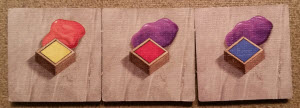
Painting up a storm
To visit the wall, the expansion provides a new action space on worker boards that temporarily replaces one of the five base locations with a trip to the wall instead, as chosen by the player. The wall action is only available once per round. Each tile is worth 4 VP, requires one secondary paint color, and a player may only complete a wall tile orthogonally adjacent to another completed space.
A completed wall tile is flipped over, revealing a paint color. These tiles provide residual paint tokens at the end of each round, up to one paint per color. Additionally, instead of mixing paints, a player may take a Workshop action to turn in two primary colored wall residuals for the corresponding secondary-colored Exchange tile. This Exchange tile provides a residual of that color at the end of the round instead.
The Rundown
The Wall Fresco is a little deceiving in that it initially appears to be another expansion that would slow the game down by adding another area to focus on. In fact, the opposite is true. This speeds up the tempo of the game and successfully doubles down on the fun of painting tiles. It doesn’t make a lot of thematic sense that adding another area to paint actually makes the game quicker, but that is what happens here.
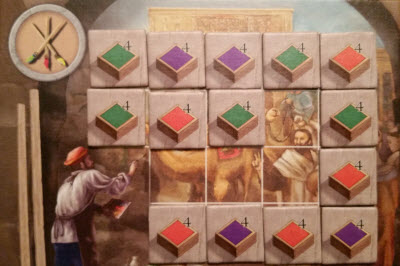
Carving up the Wall Fresco for fun and profit.
Instead of competing in the Market, you now have an alternate means of gaining paint by completing wall tiles. You’re even able to get a paint residual as early as the first round. Getting free paint every turn is incredibly useful, saving you money and lessening the importance slightly of competing over turn order. It also creates a nice self-sustaining engine in that you’re able to mix tiles to get secondary paint residuals that can be used on further wall or ceiling frescoes.
This expansion can either make games of Fresco quicker by itself or in tandem with The Bishop’s Request (Expansion 2), as these two expansions play off one another incredibly well. In particular, it provides an alternative VP path beyond just pivoting paint residuals into fresco tiles. Plus, if you’re using lots of other expansions that will be pulling your attention away from basic things like getting paint, this one can also help smooth out getting those resources.
Expansion 10: The Medico
It would appear that the demands of the bishop have caught up to the patrons, as fatigue and illness are now setting in among the painter’s Apprentices.
Rules Creep Factor
The Medico is the largest and most game-changing of all Fresco’s expansions, affecting most areas of the game to some degree. The Medico centers around the addition of a medico board that houses a stack of medicine bottle tiles, Infection tiles, and a pile of black Apprentice workers representing sick workers.
Fatigue and sickness spreads around the restoration camps in the form of the Infection tiles. After players have revealed their actions for the round, the top Infection tile is shown, designating which location falls ill. Flipping the last Infection tile also triggers the final game round. After resolving their workers at the infected location, players then swap any Apprentices with sick Apprentices on the medico board. Additionally, if a player assigns both sick and healthy workers to the same location, all healthy workers become sick afterwards.
Sick workers are still assigned like normal workers but are far less useful. Sick workers are not allowed at the Market, Theater, or action spaces of expansions. Moreover, sick workers cannot paint fresco tiles near the Bishop, can only mix paint once instead of twice, and costs them a primary paint token to receive money at the Studio.
To cure them, players must use medicine. To purchase it, The Medico provides a new action space on worker boards that temporarily replaces the normal Market location with a trip to the medicine tent instead. The medico action is only available once, but it doesn’t require an Apprentice. It does, however, allow for one healthy Apprentice to visit the Market per usual. At the beginning of each round after the first, a number medicine bottles revealed equal to player size. Green bottles contain 1-3 cure rations, while red bottles do not.
At the end of each round, players may use their medicine bottles to cure some or all of their workers. Red bottles by contrast raise Morale by 1.
Each healthy Apprentice at the end of the game is now worth 5 Thalers.
The Rundown
No expansion in Fresco is as game-changing as The Medico. It adds an entirely new angle to the game by constantly having to manage your workers and keeping them from getting sick. The Medico doesn’t aid you in new ways for VP. Instead, it slows the game down and forces players to be more methodical and either take a varied approach to their rounds, or risk a big chunk of your workforce catching the plague.
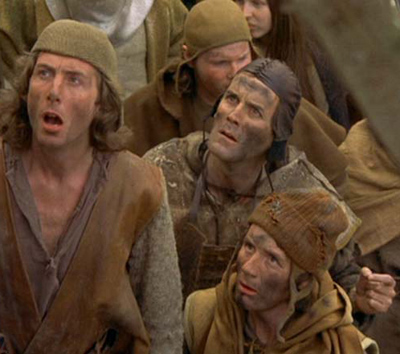
They got better…
Players aren’t just managing their worker’s health – they also have to mitigate the random elements it brings. Whether or not you will be affected each round is dependent on the significant randomness of the Infection tiles, and not everyone will enjoy that feeling.
It can be particularly frustrating sending three workers to the Market or Studio only to have that location get all sickified on you while your opponents are completely unaffected. Like most disease, it’s indiscriminate, but you have to be ready to adjust accordingly. Between being unable go visit half the locations while sick and being handcuffed at the others, having a crippled worker pool for long periods of time will affect your changes at winning.
The Medico is also the one expansion with any real series of rules ambiguities due to how pervasive it affects the game. However, it’s still largely straightforward with the base game, aside from some confusion over whether or not you can go beyond six workers by exchanging your bonus worker for a sick one. (Spoiler: you cannot.)
The Medico is an impressive expansion given how much it changes the tone of the game, and it certainly adds a flavor unlike any of the others. However, it doesn’t generally play well with other expansions because of how much focus is required just to keep your workers healthy and be able to paint normally. It’s highly recommended that you play The Medico by itself or only with a couple minor expansions. To actually enjoy The Medico and not have it feel like a punishment, avoid combining it with other expansions that also have a lot of luck (Expansions 5, 7, 11) or those that are complex in their own right, as they’re bound to just compound frustrations (Expansions 6,8).
Expansion 11: The Bishop’s Favor
The bishop is offering up minor bonuses for a job well done.
Rules Creep Factor
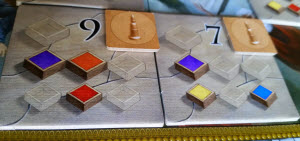
They look good enough to discard.
The Bishop’s Favor is the smallest of the expansions, adding a tiny face-down favor tile to each fresco at the Cathedral at the beginning of the game. Favor tiles provide Morale, money, VP, or a primary paint token.
When restoring a fresco, if the Bishop marker is on its location, the player also gains the favor token reward.
The Rundown
The Bishop’s Favor has no impact on the game beyond incentivizing players to want the Bishop on the restored tile even more than they already do. The bonuses are rather small and random, and while occasionally getting 5 Thalers or a free paint token is nice, they aren’t going to alter much.
That being said, it does add a ton of unnecessary fiddliness to a generally streamlined game board. Unless you get to claim the token, you’re just clearing it with no effect, which is clunky and unnecessary. Instead, we recommend just making a stack of them off the board and revealing the top one as needed. It’s far cleaner that way. Otherwise, it’s more trouble than its worth.
![]()
The Final Takeaway
The Fresco Big box offers a plethora of ways to alter the game, from changing the length of playthroughs to how much extra complexity or luck is desired. The eleven expansions provide enough variation that players will be able to find the ideal degree of Fresco-ness they prefer. Just don’t try to use all of them together. It’s tempting, but it’s ultimately a bad idea. Part of Fresco’s charm is that it’s a light worker placement with a pleasant theme, and the more that gets piled on, the further the game moves from that sensation.
The impact of the expansions on group preferences shifts only mildly. While Tacticians and Architects will find most expansions add to their appreciation of Fresco, anything more than the simplest modules will push Socializers away. To them, the base game is about as complex as they want.
Similarly, Strikers should avoid any of the swingier or more luck-based expansions that can disrupt Fresco’s tight point control, or else they will sour on the game. Daredevils, however, will enjoy setups with more expansions than less, as it will give them additional room to play with alternate point strategies. They should be careful of having too many though, or they’ll be right back on the fence. Likewise, the expansions will endear Immersionists to the game more, particularly with heavily thematic expansions such as The Glaziery and Wishing Well.
The main obstacles to avoid with these additions are using more than one of the three larger expansions together (Glaziery, Bells, or Medico), and ensuring that only one expansion that changes how the ceiling frescoes behave is in use at a time (Expansions 3, 5, 6, 7, 11). Surprisingly, expansions don’t get in each other’s way rules wise, but overloading still isn’t encouraged. Too many will result in players having a hodgepodge approach to the game, easily getting lost among too many strategic options or restrictions. Choosing a few, however, can make an already decent Fresco experience better. The Fresco Big Box offers players a fantastic mosaic of opportunities for replayability and customization. The Big Box is, quite assuredly, a work of art.
Fresco is a product of Queen Games.
Cardboard Republic Snapshot Scoring (Based on scale of 5):
Artwork: 4.5
Rules Clarity: 4.5
Replay Value: 5
Physical Quality 5
Overall Score: 4.5

